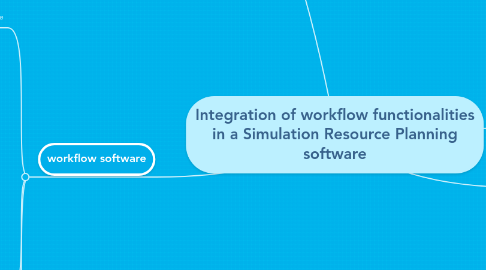
1. Schedule
1.1. Thesis Start
1.2. double supervisioning
2. workflow software
2.1. Open Source
2.1.1. Activiti
2.1.1.1. minuses
2.1.1.1.1. need a bit of coding if you want to orchestrate services
2.1.1.1.2. Not all BPMN-elements are realized
2.1.1.2. benefits
2.1.1.2.1. easy to use
2.1.1.2.2. AngularJS Web-Modeler
2.1.1.2.3. BPMN 2 process engine
2.1.1.2.4. Activiti Explorer
2.1.1.2.5. under the Apache license
2.1.2. JBoss — BPMSuite
2.1.3. jBPM 6.3 release
2.1.3.1. integrated with drools
2.1.3.1.1. allowing you to model and execute complex business scenarios
2.1.3.2. minuses
2.1.3.2.1. scalability
2.1.3.2.2. low level programming
2.1.3.3. supports the complete lifecycle
2.1.3.3.1. providing you tools for authoring your processes and rules and a repository to manage and store your processes
2.1.4. BonitaSoft
2.1.5. links
2.1.5.1. http://testingflavors.blogspot.de/2014/07/jbpm-and-activiti-analysis-business.html
2.2. Business Process Management Software
2.2.1. monitor
2.2.2. evaluate and categorize
2.2.3. ... maintain tasks and processes
2.3. Paid
2.3.1. Intalio (paid sw, but has a free core)
2.3.1.1. http://www.intalio.com/
2.3.2. Infinity/Stardust (commercial)
2.3.2.1. supporting more BPMN2 elements
2.3.2.2. under the Eclipse Public License
2.3.2.3. developed by the German startup CARNOT AG
2.3.2.4. The Infinity Process Platform is Stardust under a commercial license
2.3.3. Camunda
2.3.3.1. https://camunda.com/bpm/enterprise/quote.php
3. Tasks
3.1. Identification and documentation of requirements
3.1.1. Workflow functionality
3.1.2. technical requirements
3.1.2.1. analyzing and decomposing the elements of workflow patterns
3.1.2.1.1. metamodels
3.1.2.1.2. formats
3.1.2.1.3. how to store them
3.2. solution approaches
3.2.1. existing wf engines
3.2.2. hybrid
3.2.3. own
3.3. evaluation scheme
3.3.1. Technical criterias
3.3.1.1. design and algorithm issues
3.3.2. non-technical criteria
3.3.2.1. licensing
3.3.2.2. adaptability
3.3.2.3. speed of development
3.4. Development of a proof-of-concept prototype
3.4.1. feasibility of integration of selected solution approach
4. design
4.1. Workflow Model
4.1.1. Budget
4.1.2. Data Model
4.1.2.1. Type of data
4.1.2.2. Sources of data
4.1.2.2.1. external
4.1.2.2.2. internal
4.1.2.3. Structure of the data
4.1.2.4. use metamodels?... takes generic infrastructure design and assign assets to create flexible WF
4.2. Workflow Components
4.2.1. General
4.2.1.1. output description
4.2.1.1.1. he information, material and energy produced by the step and provided as input to downstream steps.
4.2.1.2. transformation rules and algorithms
4.2.1.2.1. may be carried out by associated human roles or machines, or a combination
4.2.1.2.2. State Transitions
4.2.1.3. input description
4.2.1.3.1. the information, material and energy required to complete the step
4.2.2. Diagramm
4.2.2.1. tasks
4.2.2.2. connectors
4.3. language for business process modeling
4.3.1. BPEL
4.3.2. BPMN
